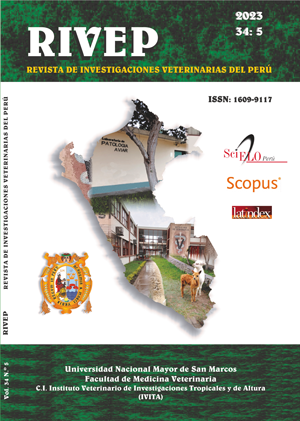Evaluation of down and coarse fibres of llamas (Lama glama) K’ara raised in high Andean conditions of Peru
DOI:
https://doi.org/10.15381/rivep.v34i5.24817Keywords:
fineness, productive characteristics, fibre, South American camelidsAbstract
The objective of this work was to evaluate characteristics of quality, growth and yield to dehairing of the down and coarse fibres of K'ara llamas, as well as the effect of factors that may affect their characteristics. In total, 69 K'ara llamas were used, 49 from the CICS-Lachocc of the Universidad Nacional de Huancavelica (UNH) and 20 from the Rural Community of San Miguel de Mestizas (CC Mestizas) of the department of Apurímac (Peru). Fibre samples were taken from three body areas: shoulder (P), rib (C) and hind flank (N) and the age, sex, live weight and fleece weight of manually sheared llamas were recorded. In addition, the length and growth rate of fine fibres (down) and coarse fibres (guard hair) were determined with a millimetre metal ruler. To determine the yield when dehaired, 20 fibre samples were dehaired manually. The mean fibre diameter (MDF), the coefficient of variation of the MDF (CVMDF) and the percentage of fibres smaller than 30 microns (Fib<30mic) of down and guard hair fibres were determined using the FIBER EC. The live and fleece weight was 87.9 ± 26.4 kg and 1175.1 ± 675.9 g, respectively, and the MDF and CVMDF of down fibres was 21.3 ± 2.0 µm and 18.9 ± 1.4%, and of thick fibres 49.8 ± 9.4 µm. and 24.7 ± 6.3%, respectively. The growth of down fibres was 5.2 ± 0.8 mm/month, and that of guard hair was 9.7 ± 1.0 mm/month. The yield in the dehaired was 71 ± 8.5% of down fibres and 16 ± 7.4% guard hairs. There was an effect of live weight on MDF and Fib<30mic in fine and coarse fibres, and additionally in coarse fibres, also live weight had an effect on CVMDF, while fleece weight had an effect only on MDF. Likewise, there was an effect of sex on the monthly growth of the fibres and on the yield to dehairing of down and guard hairs. In conclusion, the down fibres of the K'ara llamas, due to their good diameter, length, uniformity and high percentage in the fleece, can be processed to obtain fine garments.
Downloads
Downloads
Published
Issue
Section
License
Copyright (c) 2023 Edgar Quispe Peña, Virgilio Machaca Machaca, Valeriano` Paucara Ocsa, Rufino Paucar-Chanca, Max Escobedo Enriquez, Jorge Luis Huere Peña, Jorge Luis Aliaga Gutiérrez

This work is licensed under a Creative Commons Attribution 4.0 International License.
AUTHORS RETAIN THEIR RIGHTS:
a. Authors retain their trade mark rights and patent, and also on any process or procedure described in the article.
b. Authors retain their right to share, copy, distribute, perform and publicly communicate their article (eg, to place their article in an institutional repository or publish it in a book), with an acknowledgment of its initial publication in the Revista de Investigaciones Veterinarias del Perú (RIVEP).
c. Authors retain theirs right to make a subsequent publication of their work, to use the article or any part thereof (eg a compilation of his papers, lecture notes, thesis, or a book), always indicating the source of publication (the originator of the work, journal, volume, number and date).










